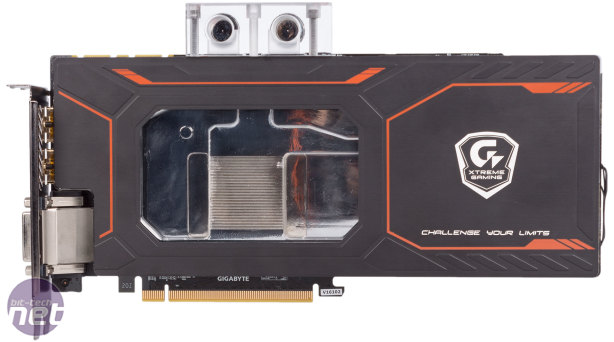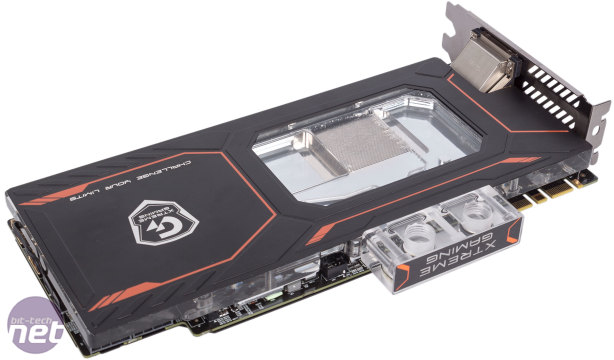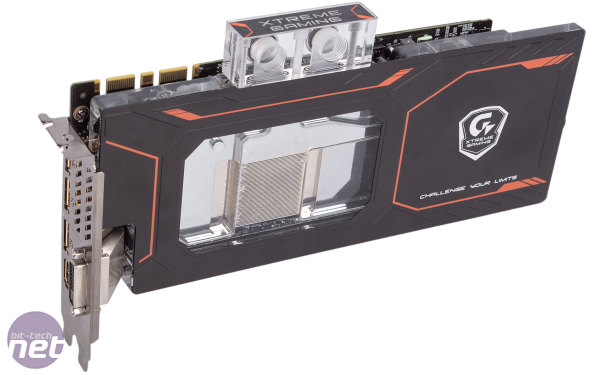Gigabyte GeForce GTX 1080 Xtreme Gaming Waterforce WB Review
December 9, 2016 | 11:40

Performance Analysis
There was never any question about whether this would be a fast card, and the numbers speak for themselves. It's a real monster at 1440p with all but one game having minimum frame rates of 60fps or more. At 4K, it starts to hit its limits with a couple of sub-30fps minimum results, but as long as you're happy to drop from 'Ultra' to 'High' settings in some games then this shouldn't be a common problem.Of course, at this end of the market cards are pretty far removed from the price-performance curve. Adding a custom water-cooling solution to an already premium card only increases the diminishing returns when considered from a pure performance perspective. For example, while this card is faster than other custom GTX 1080s like the EVGA GTX 1080 FTW, it's only by marginal amounts – three percent on average here. Similarly, there are clear gains over a pimped out GTX 1070, but this £830 card is still only 20 percent faster than the £430 Palit GTX 1070 in our charts.
These comparisons are worth noting but they're not really the right way to assess a card like this. Anyone even considering an overclocked GTX 1080 will be expecting to part ways with a pretty hefty wad of cash, so the question is whether or not the GTX 1080 Xtreme Gaming Waterforce WB delivers in the areas the liquid-cooling enthusiasts care about.
The first thing we noted was just how fast the card was running. With temperatures so low, Nvidia's GPU Boost 3.0 technology was essentially free to push things to the edge of the boost curve. Despite a rated boost clock of 1,923MHz in OC Mode, the card actually sustained 2,050MHz throughout all of our testing. This is excellent – we've tested cards that cannot overclock to this level, let alone run at them out of the box. Gigabyte's GPU Gauntlet programme certainly appears to be paying off.
To cool the card, we used a single slimline 240mm radiator with a single row of fans, a 12V pump and a medium-sized reservoir. The GPU was the only water-cooled component in the loop, but even so we think the setup is sensible and representative rather than overkill. With the loop up and running, temperatures under load were simply outstanding: A delta T of 14°C is far, far below what we see from even low-power air-cooled cards. That was with fans running at 12V, however, which was a bit of an affront in terms of noise. As such, we switched to a much quieter 5V setting and were pleased to see that the temperature barely changed, settling at a delta of 17°C – a fantastic result that suggests you could easily cool this card in effective silence while still keeping temperatures very healthy indeed.
Power consumption figures also suggest the card is rather efficient, with our whole system staying below the 350W mark. In fact, using this card saved us 20W in peak power consumption over the EVGA GTX 1080 FTW, suggesting Gigabyte has done a solid job with its PCB components and/or is picking GPUs with high power efficiency in its sorting programme.
We achieved pretty ridiculous speeds on both the core and memory, higher on both fronts than we've seen with any other GTX 1080 by some margin. It's possible that we've been sent a so-called golden sample, and it's also possible that long-term stability at these speeds wouldn't be possible, but it's still impressive and indicative of water-cooling's potential to improve your overclocking. Performance improved by between five and nine percent, increasing the distance between this card and the EVGA air-cooled one
Conclusion
At over £830, the Gigabyte GTX 1080 Xtreme Gaming Waterforce WB is a very niche product, and even within the world of water-cooled GTX 1080s it's pretty pricey. There's a selection of all-in-one solutions out there that are easily the most cost-effective means since you don't have to buy the components for a loop. Meanwhile, competing custom solutions from MSI and EVGA are a little less expensive, for example, and you can also buy a card and the appropriate water block and backplate for a little less, or even pay Overclockers UK to do it for you, in which case you'll also get a warranty. That said, the difference between these various solutions isn't massive. People in this market are clearly willing to pay for quality and on that front Gigabyte's card here has serious enthusiast credentials.To start with, there's little more it could do to look and feel like a premium part. It's truly rock solid and lovely to just hold in your hands. The aluminium front and back covers coupled with the full PCB coverage and topped off by bright RGB lighting that illuminates the acrylic is a winning combination in our eyes, but you're free to disagree. The two internal HDMI ports will definitely appeal to VR users too. It's also a brilliant example of water-cooling in action, delivering extremely low temperatures even in a fairly modest loop with slow spinning fans. Clock speeds are consistently high as a result, and the card is efficient too. The water block appears very well designed, covering virtually all critical components properly. The upgraded PCB elements are also nice touches, and while it's impossible to determine the effect of these upgrades the overclocking results certainly suggest Gigabyte is doing something right, but we can't draw too firm conclusions from just a single sample. Having a four-year warranty on a custom water-cooled part is also very reassuring.
Long story short, we're having a hard time finding any real fault with this card once you get over the price. If you're in the market for a custom water-cooled GTX 1080 we can wholeheartedly recommend this one.


MSI MPG Velox 100R Chassis Review
October 14 2021 | 15:04











Want to comment? Please log in.